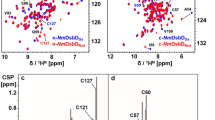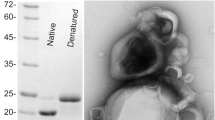Abstract
GNA1946 (Genome-derived Neisseria Antigen 1946) is a highly conserved exposed outer membrane lipoprotein from Neisseria meningitidis bacteria of 287 amino acid length (31 kDa). Although the structure of NMB1946 has been solved recently by X-Ray crystallography, understanding the behaviour of GNA1946 in aqueuos solution is highly relevant for the discovery of the antigenic determinants of the protein that will possibly lead to a more efficient vaccine development against virulent serogroup B strain of N.meningitidis. Here we report almost complete 1H, 13C and 15N resonance assignments of GNA1946 (residues 10–287) in aqueous buffer solution.
Similar content being viewed by others
Biological context
Neisseria meningitidis is an encapsulated, Gram-negative bacterium that colonizes the upper respiratory tract of humans. During invasive infection, the bacterium enters the bloodstream, where it multiplies to high density and causes a form of sepsis characterized by the dramatic disruption of the endothelium and microvasculature. From the bloodstream the bacterium can cross the blood–brain barrier and cause meningitis, which mostly affects infants, children, and adolescents who do not have bactericidal antibodies to the infecting strain. Although conjugate vaccines against serogroups A, C, Y, and W-135 were proven to be safe and effective in eliminating the disease, the poor immunogenicity of the serogroup B capsular polysaccharide and its cross-reactivity toward human tissues have stressed the need to develop a universal vaccine covering all meningococcal strains (Giuliani et al. 2006). A few years ago we determined the sequence of the genome of a meningococcus B strain (MC58) and used it to discover novel protective antigens (Pizza et al. 2000). Among them we identified GNA1946, a highly conserved lipoprotein sharing homology with periplasmic ABC methionine transporters (Pizza et al. 2000; Jacobsson et al. 2006; Peng et al. 2008). Yang and colleagues have recently solved the crystallographic structure of GNA1946 and postulated a high affinity binding to l-methionine, hypothesizing a role as an initial receptor of the ABC transporter family (Yang et al. 2009). In this study, we report the 1H, 13C and 15N chemical shift assignments of GNA1946 in aqueous solution.
Methods and experiments
Cloning, expression and purification of GNA1946 antigen
GNA1946 was amplified from a NMB genomic DNA library using the following primers NMB1946_BamHI_S; (ACTGGGATCCATGAAAACCTTCTTCAAAACCC) and NMB1946_XhoI_AS (ACTGCTCGAGTTATTTGGCTGCGCCTTCATTCC) and subsequently subcloned into pGEX-6P-1 vector using BamHI and XhoI as restriction sites. Uniformly 13C,15N-labelled protein was expressed in Escherichia coli C43(DE3) strain (Lucigen) in M9 medium containing 0.1% 15N-ammonium chloride, 0.2% 13C-glucose (Cambridge Isotope Laboratories) and 50 μg/ml ampicillin (Sigma). Protein expression was induced with 1 mM IPTG (isopropyl β-D-thiogalactosidase). After 16 h incubation at 293 K cells were centrifuged and the cell pellet was resuspended in GST buffer at pH 8.0 and lysed by sonication. The recombinant protein was purified using a column containing Glutathione Sepharose 4 Fast Flow (GE Healthcare) pre-equilibrated with GST buffer. Sample purity was monitored by SDS–PAGE. Thermolysin (Sigma) was used to remove the GST tag from the recombinant protein. After enzymatic reaction, the proteins were separated by gel filtration on a column packed with Superdex 200 (GE Healthcare). The protein-rich fractions were pooled and then subjected to a final purification step on Gluatahione Sepharose 4 Fast Flow column to remove the residual GST and uncleaved fused-protein. Finally GNA1946 was dialyzed three times against 100 volumes of 200 mM NaCl, 0.05% NaN3, 20 mM sodium phosphate buffer, pH 7.0, concentrated to 0.5 mM, supplied with 5% D2O and used directly for the NMR measurements.
NMR spectroscopy
All spectra were recorded at 298 K on a Bruker Avance 900 MHz spectrometer equipped with a cryoprobe. Sequence-specific resonance assignment was accomplished based on a combination of triple-resonance experiments as well as 15N- and 13C-HSQC-NOESY spectra. Backbone assignment was performed based on the set of HNCO/HN(CA)CO and HNCA/HN(CO)CA experiments (Yamazaki et al. 1994). Additionally, CBCANH and CBCA(CO)NH spectra (Shan et al. 1996) were evaluated whenever possible to confirm the assignments made and derive information on Cβ chemical shifts. Side-chain resonance assignments were accomplished with HCCH-TOCSY experiments (Kay et al. 1993). Finally, chemical shifts were obtained by picking peaks in a 13.3 ms constant-time 1H,13C-HSQC spectrum (Vuister and Bax 1992). The aromatic ring systems of Phe, Tyr, His, and Trp residues were picked in a 8.8 ms constant time 1H,13C-HSQC and correlated with β-carbons via the HBCBCGCDHD experiment (Yamazaki et al. 1993). All chemical shift values were finally derived from the position of peaks in the 1H,15N-HSQC and the constant time 1H,13C-HSQC spectra. All experiments employed pulsed-field gradients (Keeler et al. 1994). Data were processed with TOPSPIN 2.1 (Bruker) and analyzed with the CCPNMR Analysis 2.1 software (Vranken et al. 2005).
Assignment and data deposition
The GNA1946 protein in aqueous buffer gives a well-resolved 1H,15N-HSQC spectrum which is a clear indication of a well-folded protein. Moreover the sample is highly stable and displays no degradation over a half a year period as demonstrated by an identical pattern in the 1H,15N-HSQC spectrum. The presence in the initial spectrum of several less intense but very sharp peaks suggests, however, minor degradation upon initial sample preparation. The 1H,15N-HSQC of GNA1946 is shown in Fig. 1. The overall backbone assignments have been completed to approximately 96% for the non-prolyl 1HN-15N resonances, 98% for the 13Cα and 95% for the 13C′ resonances that could be detected in the spectra. The N-termini residues M1 to S9 have not been assigned because of line broadening most likely due to solvent exchange and/or conformational exchange. Of the remaining 278 residues, more than 95% of the backbone resonances and more than 87% of the side chains resonances were unambiguously identified, including the assignment of 85% of the 1H side chain resonances. Chemical shifts were deposited in the BioMagResBank (http://www.bmrb.wisc.edu) under the accession number BMRB 17250. The secondary structure of GNA1946 was evaluated by calculating the backbone torsion angles using TALOS + program (Shen et al. 2009). As shown in Fig. 2, TALOS + restraints were obtained for 143 residues and suggest the presence of 15 α-helices (residues 54–60, 63–68, 86–91, 103–112, 136–138, 152–164, 179–182, 198–200, 202–207, 216–221, 225–228, 246–248, 251–258, 261–271 and 279–282) and 10 β-strands (residues 44–49, 73–78, 96–99, 115–119, 126–129, 143–147, 191–194, 209–213, 233–235 and 239–243) that are in well correspondence with the available X-ray structure (Yang et al. 2009).
References
Giuliani MM, Adu-Bobie J et al (2006) A universal vaccine for serogroup B meningococcus. Proc Natl Acad Sci USA 103(29):10834–10839
Jacobsson S, Thulin S, Molling P, Unemo M, Comanducci M, Rappuoli R, Olcen P (2006) Sequence constancies and variations in genes encoding three new meningococcal vaccine candidate antigens. Vaccine 24(12):2161–2168
Kay L, Xu GY, Singer AU, Muhandiram DR, Forman-Kay JD (1993) A gradient-enhanced HCCH-TOCSY experiment for recording side-chain 1H and 13C correlations in H2O samples of proteins. J Magn Reson Ser B 101:333–337
Keeler J, Clowes RT, Davis AL, Laue ED (1994) Pulsed-field gradients: theory and practice. Methods Enzymol 239:145–207
Peng J, Yang L et al (2008) Characterization of ST-4821 complex, a unique Neisseria meningitidis clone. Genomics 91(1):78–87
Pizza M, Scarlato V et al (2000) Identification of vaccine candidates against serogroup B meningococcus by whole-genome sequencing. Science 287(5459):1816–1820
Shan X, Gardner KH, Muhandiram DR, Rao NS, Arrowsmith CH, Kay LE (1996) Assignment of N-15, C-13(alpha), C-13(beta), and HN resonances in an N-15, C-13, H-2 labeled 64 kDa trp repressor-operator complex using triple-resonance NMR spectroscopy and H-2-decoupling. J Am Chem Soc 118(28):6570–6579
Shen Y, Delaglio F, Cornilescu G, Bax A (2009) TALOS+ : a hybrid method for predicting protein backbone torsion angles from NMR chemical shifts. J Biomol NMR 44:213–223
Vranken WF, Boucher W et al (2005) The CCPN data model for NMR spectroscopy: development of a software pipeline. Proteins 59(4):687–696
Vuister GW, Bax A (1992) Resolution enhancement and spectral editing of uniformly 13C-enriched proteins by homonuclear broadband 13C decoupling. J Magn Reson 98:428–435
Yamazaki T, Forman-Kay JD, Kay LE (1993) 2-dimensional NMR experiments for correlating C-13-beta and H-1-delta/epsilon chemical-shifts of aromatic residues in C-13-labeled proteins via scalar couplings. J Am Chem Soc 115(23):11054–11055
Yamazaki T, Lee W, Arrowsmith CH, Muhandiram DR, Kay LE (1994) A suite of triple-resonance NMR experiments for the backbone assignment of N-15, C-13, H2- labeled proteins with high sensitivity. J Am Chem Soc 116(26):11655–11666
Yang X, Wu Z, Wang X, Yang C, Xu H, Shen Y (2009) Crystal structure of lipoprotein GNA1946 from Neisseria meningitidis. J Struct Biol 168(3):437–443
Acknowledgments
This work was supported by the Sixth Research Framework Programme of the European Community, FP6-STREP project ‘‘BacAbs’’, grant number LSHB-CT-2006-037325.
Open Access
This article is distributed under the terms of the Creative Commons Attribution Noncommercial License which permits any noncommercial use, distribution, and reproduction in any medium, provided the original author(s) and source are credited.
Author information
Authors and Affiliations
Corresponding author
Rights and permissions
Open Access This is an open access article distributed under the terms of the Creative Commons Attribution Noncommercial License (https://creativecommons.org/licenses/by-nc/2.0), which permits any noncommercial use, distribution, and reproduction in any medium, provided the original author(s) and source are credited.
About this article
Cite this article
Neumoin, A., Leonchiks, A., Petit, P. et al. 1H, 13C and 15N assignment of the GNA1946 outer membrane lipoprotein from Neisseria meningitidis . Biomol NMR Assign 5, 135–138 (2011). https://doi.org/10.1007/s12104-010-9285-y
Received:
Accepted:
Published:
Issue Date:
DOI: https://doi.org/10.1007/s12104-010-9285-y






